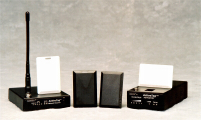May 14, 2003 – Axcess, a Dallas, Texas, company that offers security and asset tracking systems, has developed an active (battery-powered) RFID tag that can be embedded in identity cards. The cards can be read from up to eight feet away, and can even be read through water or walls.
A reader placed near a doorway emits a signal at 132 kHz, which wakes up the identity tag when someone comes within range. The identity card then begins transmitting its unique identifier at a 315 MHz. The longer read range eliminates bottlenecks at the doorway, according to Ben Donahue, VP of business development, for Axcess.
Passive tags operating at 125 kHz and 13.56 MHz have very short read-ranges and aren’t as effective at securing assets and tracking individuals carrying RFID-enabled identity cards, he says. And these passive systems can easily be thwarted by obstructions.
The product carries an manufacturer’s suggested retail price of about $1,200 to $1,400 per portal for the hardware, which consists of a reader with an antenna, tag activator and receiver. Each active tag costs from $16 to $50, depending on the application. Identity card tags are the simplest application. But the active tag can be integrated with Axcess’s Universal Sensing Appliance to track assets.
The appliance is an active tag with input/output connections, so it can be wired to a temperature sensor, or even a radiation detector (see Axcess Unveils Sensing Appliance). The system can be programmed to send specified data to a company or government agency’s data systems via TCIP or WIGAN, which allows the data to ride on an existing infrastructure.
The Axcess Active Tag comes with an embedded battery, which transmits a wireless signal to receivers located at doorways and gates within a facility. By adding receivers to a local network, assets, such as laptops, and personnel can be tracked more closely. Once inside an establishment, tag holders are automatically identified and tracked throughout a facility. By using software to assign access privileges for certain assets, companies can use the tags to ensure personnel do not handle assets, inventory, or vehicles without authorization.
Companies and government facilities that choose to use the tags will be able to speed up access to buildings and create a more secure and monitored environment once entrants are inside, according to Donahue. Person’s entering restricted areas are also more easily identified, and the system can be set up to alert security when a door opens, but an authorized card is not read.
The technology could also be used in airline frequent flyer ID cards to more quickly identify and track passengers, and match baggage tags to travelers. Donahue says the company’s identity cards have already been integrated into third party systems including Honeywell’s EBI system for asset location. — Jennifer Maselli
Learn how RFID can benefit your company. Register for RFID Journal Live!, an executive conference being held in Chicago from June 11 to 13, 2003.


